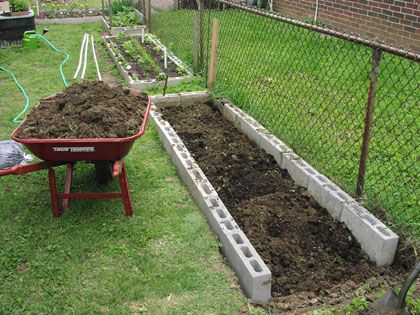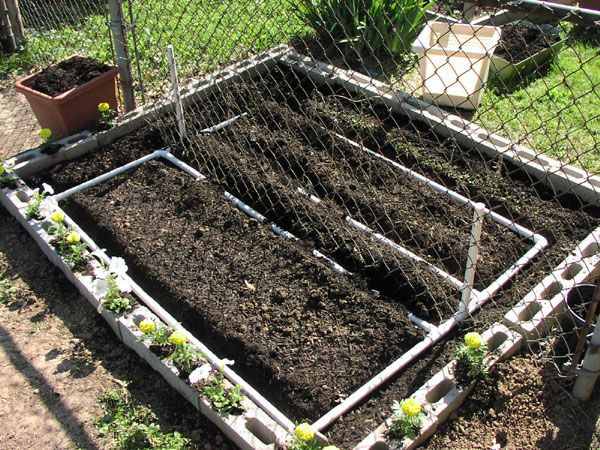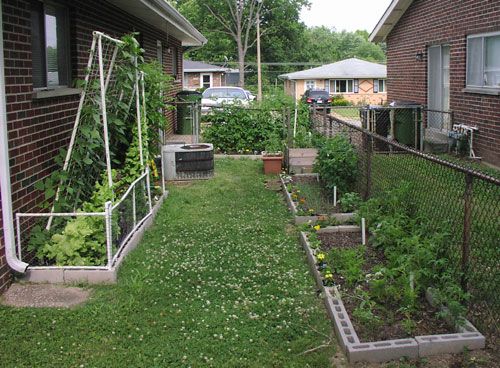They just turn around and jack up your premiums, delay or deny payments to providers, and slash payments to providers. They also keep paying off their government lackeys to keep any serious regulation off their backs. It’s a formula that’s worked well for them for years. Why would they change now?
Hi there, anyone have any suggestions for type of soil to buy for a raised bed? Super new at this gardening thing ?. Thanks!
Hi there, anyone have any suggestions for type of soil to buy for a raised bed? Super new at this gardening thing ?. Thanks!My suggestion would be, the best you can afford. How big are the beds? Are they small enough that you're looking at buying soil in bags, or large so you're getting a truck-load or two? In either case, try to include some manure or other organic fertilizer to mix in, as what is often sold as "garden soil" is not generally very rich. And my own lifetime preference is to figure on a thick layer of mulch on top when you've planted, as it both keeps moisture in AND breaks down and enriches the soil. My current raised beds after 20 years have soil I could only have dreamed of when it first went in, and it achieved close to that in 2 or 3 years of 8 inches of spoiled hay or straw mulch. Soil is an on-going project. I'll be interested in what other responses you get, but that's my take.
Thank you, thank you. Always welcome–now more than ever.
Most govt officials are bad people and criminal against citizens and civilians. Abuse of power is a very simple concept and little is done to stop it.
Search Results
Web results
Donald H. Rumsfeld Named Chairman of Gilead Sciences
Basically, young and working middle age people , want to just go back to living and expect elderly, sick people to protect themselves. I am feeling they( officials ) are ready to pull the plug on lockdown. And the ethics of the medical community , will be we cant help you, if you die you die. there is no cure for this… US govt will be happy, Tons of medicare and SS saved. done and done…
Coronavirus: Boris Johnson says he’s tested positive
“Speaking in a video posted on social media, he said he would work from home but continue to lead the “fightback” against the disease.”
https://www.bbc.com/news/av/uk-52065395/coronavirus-boris-johnson-says-he-s-tested-positive
https://www.cbc.ca/news/canada/british-columbia/physical-distancing-bc-covid19-coronavirus-1.5512269
Hi there, anyone have any suggestions for type of soil to buy for a raised bed? Super new at this gardening thing. Thanks!Welcome Rrobles. How tall/deep are you doing your beds? When I put mine in I didn't go that tall. I used concrete blocks for a boarder which are less than a foot tall, but I dug down about 18" below the ground as I put them in, removed the soil and then mixed in compose before putting the whole thing back into the hole. St Louis has a high percent of clay in the soil, so it gets packed tight with some rain. I wanted to loosen it up so the plants could grow deep roots. Here's a picture:

 I'm renting a duplex and my small garden is along the fence line on the South side, so it gets good sun.
One of the things you can do if you are first putting the beds in, is at the bottom lay in a layer of any twigs, sticks, leaves you have from the Winter. Its a technique called "hugelkultur". Google it. That's a good way to put a lot of organic material into your soil.
You can also add sand or other soil additives depending on what you are going to plant. Check the web for suggestions.
One thing not related to soil you can also do, is put in a underground watering system using pvc pipe.
I'm renting a duplex and my small garden is along the fence line on the South side, so it gets good sun.
One of the things you can do if you are first putting the beds in, is at the bottom lay in a layer of any twigs, sticks, leaves you have from the Winter. Its a technique called "hugelkultur". Google it. That's a good way to put a lot of organic material into your soil.
You can also add sand or other soil additives depending on what you are going to plant. Check the web for suggestions.
One thing not related to soil you can also do, is put in a underground watering system using pvc pipe.
 This is a raised bed on either side of a fence. I used 1" pvc I got from Home Depot, with connectors. The pipe in the ground has 1/8" holes drill all along its bottom length that way the water drains out into the soil under the surface. With all that clay, wet soil will glaze up and get really hard in the hot Summer. The two up pipes are what I water it with. Put two up pipes that way air has someplace to come out when you fill the bed.
Those are actually called "partitioning blocks". They are the same size as concrete blocks, but half as wide. I like them because the small holes can be filled with some dirt and flowers planted in them. Companion planting can help with insects as well as feed the local pollinators.
PVC is good for making tressels too. I've got cherry tomatoes in one and last year it was cucumbers, but I didn't have much luck with those. Might try beans this year.
This is a raised bed on either side of a fence. I used 1" pvc I got from Home Depot, with connectors. The pipe in the ground has 1/8" holes drill all along its bottom length that way the water drains out into the soil under the surface. With all that clay, wet soil will glaze up and get really hard in the hot Summer. The two up pipes are what I water it with. Put two up pipes that way air has someplace to come out when you fill the bed.
Those are actually called "partitioning blocks". They are the same size as concrete blocks, but half as wide. I like them because the small holes can be filled with some dirt and flowers planted in them. Companion planting can help with insects as well as feed the local pollinators.
PVC is good for making tressels too. I've got cherry tomatoes in one and last year it was cucumbers, but I didn't have much luck with those. Might try beans this year.
 ADDED: These pictures are from last years garden start of the season
ADDED: These pictures are from last years garden start of the season
Rrobles,
Yes, soil is an ongoing thing because the earthworms and microbial life you can’t see “eat” organic matter such as leaves, wood chips, pruned branches, grass clippings, etc. It’s always good to aim for approx a 40:1 ratio of carbon (brown) to nitrogen (green and food waste) content for composting. Work on feeding the life in the soil, and your trees, bushes, and veggies will be much happier and healthier. No glyposhate though! It’s systemic and can end up killing the pollinators and other beneficial insects.
How large an area do you have to work with? Do you want to start with one bed? Two? How many? Does the property or place where you live have any “hilly” areas? You could work on relocating it into your bed(s) and adding organic matter you have in the area if need be. What is your soil like? How much clay? sand? any humus (organic matter)? If you want to work on one (or two) bed(s) for this year’s veggies, you could be overwhelmed if you try to do too much if it’s your first year and there is a learning curve!! So, while this year’s crops are growing, you could start setting up new bed(s) for additional crops for next year, so you’re creating soil with Nature’s help rather than buying soil. For those beds you could do lasagna gardening. Which is creating alternating layers of cardboard & or newspaper (but no slick paper ads) which you moisten, add some of your existing soil with some type of nitrogen (grass clippings, “weeds”, etc.), and repeat. You can also use branches from pruned bushes but depending on how large they are they may not be fully decomposed by next year, which is ok, it leaves food for the critters.
I said “weeds” above, because collectively we don’t understand weeds and their messages (depending upon which weeds/pioneer species show up they can tell you a lot about the soil). Many of them have medicinal properties, are edible raw or cooked (some are both and some only cooked and some raw), and are nature’s healers. Once soil is disturbed and bare (Nature hates bare and disturbed soils, as well as vacuums, and it also doesn’t do straight lines.) Dandelions are a perfect example of a misunderstood pioneer species. It’s edible, medicinal, and has deep roots so it brings up important minerals from deep below to heal the soil. Some can even be used for dying paper or fibers, make wine (for example dandelion), etc. Eventually, depending on what we do or don’t do, it will “mine” itself out of a job, and the next succession of species will start to show up. Takes a really really long time, not in our timeframe we like, but the climax species (depending on the climate) are trees and a forest.
Linda
and are a vital component of good soil.
Adam sent me a link to an article about Duke University on a new way to sterilize masks using vaporized Hydrogen Peroxide. It took me a little time to find the original press release.
https://corporate.dukehealth.org/news-listing/duke-starts-novel-decontamination-n95-masks-help-relieve-shortages
While I applaud anyone doing the research, it appears this is a method mostly for large hospitals or medical centers, since it requires specialized equipment.
This highlights one facet of this crisis, that we need two tracks of research and methods, those usable by the home bound and individuals, and the methods usable in large settings.
Big difference between soil and dirt though. Dirt is dead, no life in it, is usually used for infill, and looks, smells, and feels different.
Soil is alive, feels and smells yummy. Putting your hands, no gloves, into soil is a great thing to do. “They” (don’t remember, but I’ve seen reference to studies, etc. about this topic and have experienced it myself…) have said that soil has natural anti-depressants in it.
Linda
Here is something we as individuals can use though.
https://www.ncbi.nlm.nih.gov/pmc/articles/PMC3078131/
“Evaluation of Microwave Steam Bags for the Decontamination of Filtering Facepiece Respirators”
Some good numbers and charts. Looks like you could use the bags, or I actually had picked up one of these early in the crisis.
https://www.amazon.com/gp/product/B007VBXKG2/
Under $20 and still in stock. One note, you would need to remove the metal nose band before microwaving any masks.
A Simple Way To Combat Coronavirus: Everyone Should Wear A Mask! (3/20/20)
https://youtu.be/yN3BWaEH3tY
Soil is not something you can buy. It is a 4-dimensional phenomenon, an ever-changing community of beings of all five life kingdoms in an ever-changing mineral matrix. How much rain and sunlight it receives and its history is just as much a part of what it is as any other physical or biological component.
Sorry, I don’t mean to sound discouraging, but if you are coming around asking what kind of soil to buy, just accept that you are not going to grow anything worthwhile this year. Not without spending far more on exotic inputs with long-term hidden costs than the value of any produce you are going to get out of it. Better to just go out and begin studying what you have to work with. I assume you are talking about doing something on some piece of ground that you have access to. Get a shovel or a digging fork. Turn some of your ground over. Look at it. What do you see? Anything growing in it, plant or animal? Ask yourself how much moisture it is going to get during the growing season. What other sources of water do you have available to you? Look up and around. Where is sunlight coming from? How many hours a day does your spot get? How many days on average are cloudy during the growing season? Who had this before you, and what did they do with it?
Seriously, if I had only a small piece of land to work with, and anyone thinking about “buying” soil can only be talking about a very small piece of land, the main thing I would do in year 1 is sheet mulch it and build myself the biggest compost heap that I could right smack in the middle of it.
Maybe by late summer, you would be ready to spread it out and put a few potatoes into it.
Thank you. This might be the best $17 spent in a while!
I thought your reply to a rookie gardener looking for advice was rather pathetic. We are trying to encourage people to start gardening, not crap on them for their lack of knowledge. Geez, way to be a trooper…
There are many types of bagged soils, or bulk for those who have a truck, that can be purchased to get someone started. At this juncture it is important to help people find ways to begin, even if only in a few containers so that they can learn as well as have some quick wins to build confidence. Who cares if they blow a few bucks on bagged soil? While their few veggies are growing they can sit and read the many forums here as well as other resources to find solutions for their particular spaces, and make a plan for what they can do going forward. Rome was not built over night!
Helping is the name of the game. Can/will you do that? If not, why are you here?
Jan
The town I live in now provides free compost, so I use that to fill my raised beds here.
At my previous location, I used a sheet mulching technique. I put a layer of cardboard on the existing grass and threw down a few bags of manure to attract worms. The bulk of the volume was leaves and grass clippings I saved at the end of the fall season. Basically, I bagged my lawn and dumped the grass clipping and chopped up leaves in the beds and let them sit for the winter. I shot for a mixture of 2/3 leaves and 1/3 grass clippings. In the spring, I covered the beds with 1 to 2 inches of top soil to plant in. I got an excellent crop, without fertilizing and by the end of the season, the contents were completely composted into soil.
There is a lot of info on the internet and YouTube about sheet mulching.